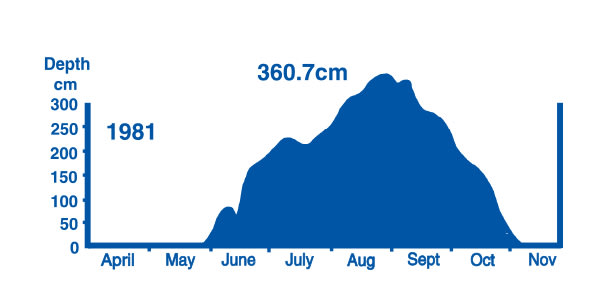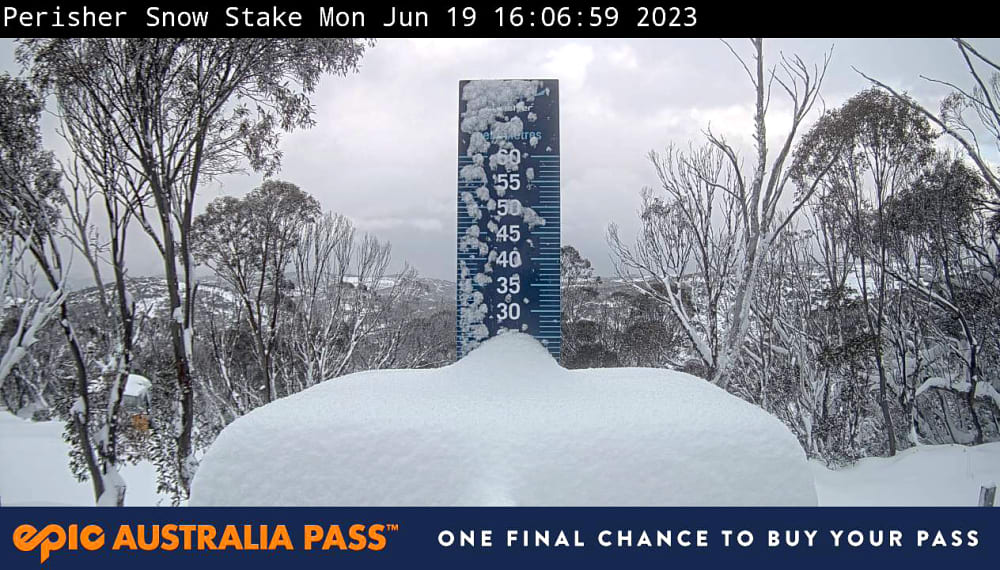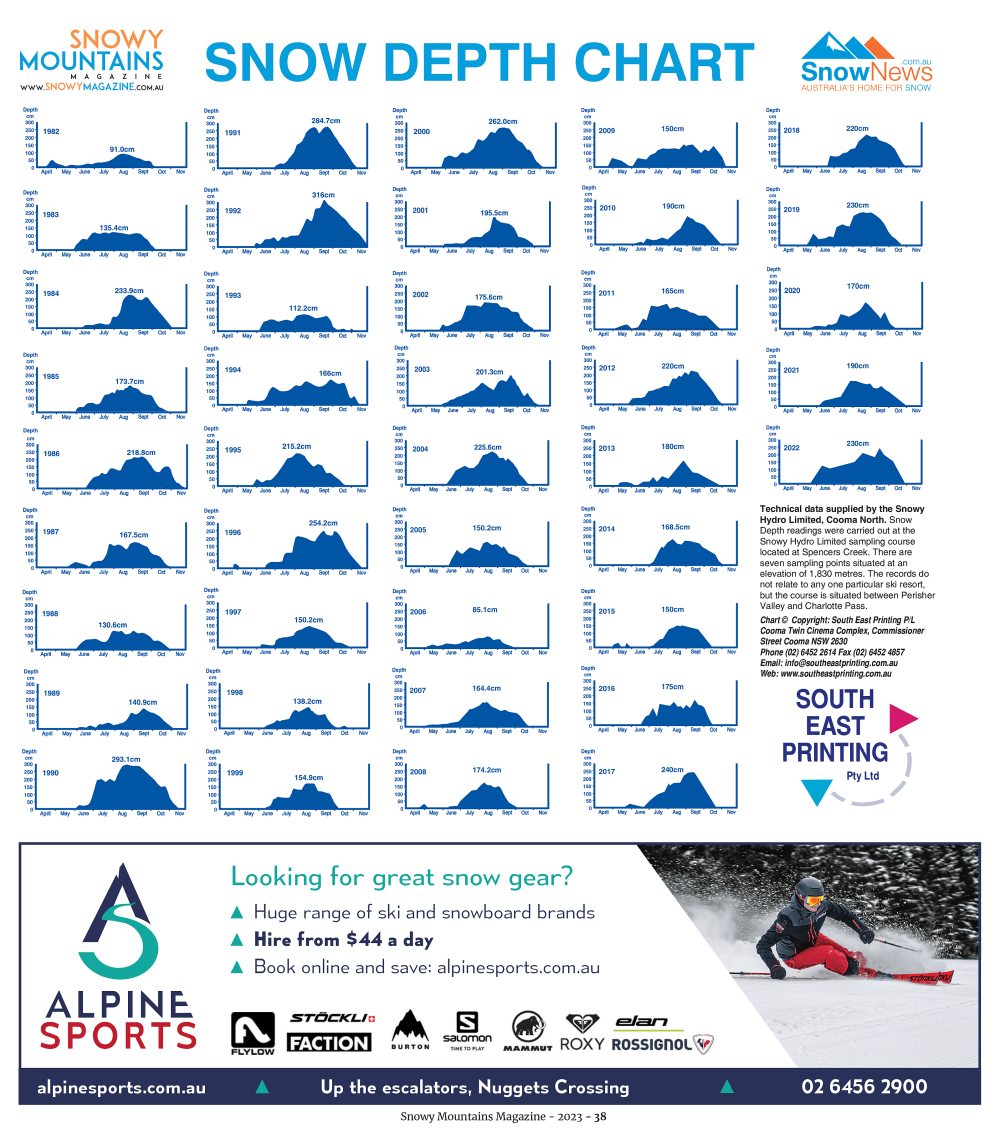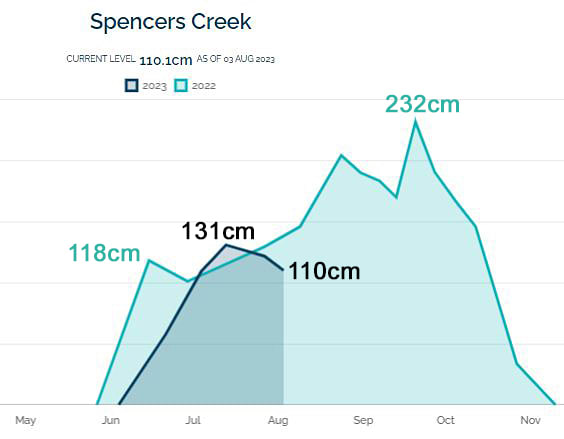IS there a more debated or discussed topic in our winter than snow. And more to the point, how much snow. We all have an opinion, some more educated than others.
What is snow depth, how do we decipher the numbers and more importantly how do you use these charts to understand what it means at your snow resort.
The NSW snow depth for each snow season dating back to 1982 are listed on the current snow depth chart (bottom of page). The huge 1981 season has fallen off the chart, so we have added it here just so you can see the biggest snow depth recorded at Spencers Creek in 1981. On the flip side, if you skied in 2006, that was the lowest depth recorded at 85.1cm.

Snowy Hydro record snow depth at various locations across the Snowy Mountains. The comparisons then used for their operational purposes across the region on the complex hydro system of dams and electricity generation.
From a snow enthusiast perspective, we just want to know how much snow is on the ground where we ski. Plus reminisce all the great days we have experienced in previous years. My first Snowy Mountains winter in 1992 I remember well. I captured my first cover shot for Ski Extra magazine at North Perisher that September. It was an incredible September where it snowed heavily, increasing in depth from 156cm on August 27, to 316cm on September 17.
We hope September 2023 is reminiscent of past big Septembers, we certainly could do with the snow.
The snow depths are read at three main locations, Deep Creek southwest of Cabramurra, Three Mile Dam near Selwyn Resort and Spencers Creek between Perisher Valley and Charlotte Pass.
Spencers Creek at 1830m above sea level is where the chart data originates. The snow depth chart does not reflect any ski resort, but the resorts use this data as an indication of snow depth. And this is where we can compare seasons by looking over old charts.
Relation of snow depths with resorts.
Avid snow visitors who know their mountain should also be aware of key elevation points around their resort.
At Perisher, the 1830m elevation is at Mt Piper, in between Smiggin Holes and Perisher. Perisher Valley is 1720m, Smiggin Holes 1680m and Blue Cow terminal at 1890m. The highest lift at Perisher is the top of the Mt Perisher double lift at 2034m, the lowest point the base of the Ridge Chair at 1605m.
The Thredbo base at Valley Terminal (Kosciuszko Chairlift) is at 1365m, and Australia’s highest lifted point is 2037m at the top of Karels t-bar. The 672m vertical is the longest in Australia. The top of Snowgums double chairlift at Thredbo is 1840m, a good indicator of the snow depth reading elevation.
Selwyn Snow Resort elevations are 1614m top station down to 1492m. Charlotte Pass has a top elevation of 1964m, and their lowest elevation is 1765m.
Currently as of early August 2023, the depth is 110cm at Spencers Creek, receding from a high in July of 131cm. If you look at resort web cams you will get an understanding of how this depth relates to different resorts. Plus consider how important snowmaking is for the resorts.
What does this all mean?
Now you know key resort elevations you need to factor in a multitude of scenarios, one being any level lower than 1830m would likely have less depth of snow. As we said originally, the snow depth is just a guide. On any given mountain you would have deep pockets of snow that are several metres deep, and other areas that may be barely covered.
Consider aspects of runs, and factor in wind direction on each given run. Most storms deliver from the west, meaning slopes that face east would have more snow blown onto them. The west facing slopes are often the least snowy slopes as they are wind scoured.
What is snow accumulation?
Resorts record amounts of new snow from each storm, starting with 24-hour time spans to give guests an idea of snowfall each day. They may also indicate 72 hour and 7-day accumulation on their snow reports. The Perisher snow stake web cam is the best example of this 24-hour recording, the stake cleared each morning at 9am for the next 24-hour period.

For the uninitiated, snow accumulation does not equal snow depth. If a storm delivers 48cm over 7 days, as Thredbo had in early July, this would not equal 48cm added onto the snow depth.
Depending on many variables, including moisture content, and in Australia’s case the excess wind we associate with snow storms, 48cm of snow accumulation may only result in 15-30cm of actual snow depth.
What is a good snow depth.
Generally a 100cm snow depth allows the resorts to open most of their lifts and most terrain, including runs with snowmaking. In early August 2023, the 110cm snow depth allowed Perisher to have 46 lifts operating, Thredbo have all key lifts except open. At this current snow depth the off piste in some areas would still be very skiable, other areas may be thin depending on their aspect
Once the depth reaches the 125cm - 150cm range it’s happy days for mountain managers as snow has likely filled in across each resort. As more storms deliver from this point, it just means for more powder days.
There is snow forecast over the next 2 weeks and would be very welcomed to assist the 2023 season.
Where is the best snow?
The patch you are skiing right now. Enjoy……
You can compare snow depths here on the Snowy Hydro website.
The current Snow Depth Chart in the Snowy Mountains Magazine below.











